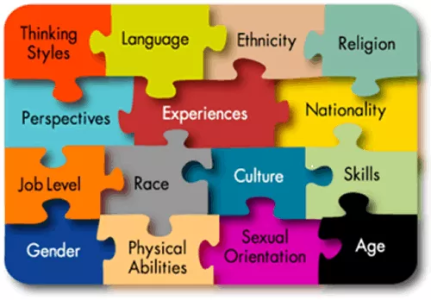Widgetized Section
Go to Admin » Appearance » Widgets » and move Gabfire Widget: Social into that MastheadOverlay zone
The Oversimplification of DEI: Looking Beyond a Racial Lens
The views expressed are those of the author and do not necessarily reflect the views of ASPA as an organization.
By Derrick Philips
February 24, 2025

Diversity, Equity and Inclusion (DEI) initiatives have gained significant traction across various industries, institutions and governmental bodies. While racial equity remains a core pillar of these efforts, the overemphasis on race as the singular or primary lens for DEI often leads to an oversimplified understanding of systemic inequities. This reductionist approach can undermine broader goals of inclusion, alienate potential allies and fail to address the intersectionality of repression.
The Problem with a One-Dimensional Approach
- The Narrowing of DEI into a “Race-Only” Framework
Many organizations approach DEI as a corrective measure solely for racial disparities, which, while critical, does not encompass the full scope of systemic inequities. Race is an essential part of the conversation, but focusing exclusively on racial demographics can obscure other dimensions of inequity, such as gender, socioeconomic status, disability, LGBTQ+ identities and religious discrimination.
For example, workplace DEI programs often measure progress through racial representation metrics, neglecting deeper issues like economic barriers, accessibility or neurodiversity. This can result in performative diversity rather than substantive inclusion.
- Alienation of Broader Participation
When DEI efforts are perceived as centering exclusively on race—especially in binary, Black vs. White terms—other marginalized groups may feel sidelined. Women, LGBTQ+ individuals, disabled workers and economically disadvantaged employees may struggle to see their experiences reflected in DEI strategies.
Additionally, individuals who do not identify as part of a racial minority but still face systemic disadvantages (such as working-class white communities) may resist DEI efforts, seeing them as exclusionary rather than beneficial to all. This misinterpretation fuels backlash and further polarizes discussions on equity.
- The Political Weaponization of Race in DEI
Conservative opposition to DEI often exploits its racial framing, portraying it as a zero-sum game where racial minorities gain at the expense of others. This oversimplification makes it easier for political actors to dismantle DEI programs under the guise of fighting “reverse discrimination” or “racial favoritism” while ignoring the broader systemic inequities DEI is meant to address.
Moreover, when race is the dominant DEI focus, efforts to address class privilege, gender disparities or ableism are often dismissed. The reality is that systemic inequities do not operate in isolation; they are deeply interwoven and must be addressed through an intersectional approach.
Reframing DEI for Lasting Impact
- Emphasizing Intersectionality
DEI initiatives must embrace an intersectional framework that recognizes how multiple identities shape experiences of oppression and privilege. Addressing only race, without considering gender, economic status, disability and other social factors, limits the effectiveness of inclusion efforts.
For example, Black women face distinct workplace challenges compared to Black men, and low-income Latinx workers experience different barriers than middle-class Latinx professionals. A genuinely inclusive DEI framework should acknowledge and address these layered disparities.
- Broadening the Narrative of Systemic Inequity
Organizations should redefine DEI as an effort to dismantle all systemic barriers—not just those related to race. This means considering how economic policies, workplace structures and institutional biases impact all marginalized communities.
For instance, rather than simply implementing racial hiring quotas, organizations could focus on inclusive hiring practices that consider economic disadvantage, first-generation professionals or candidates with non-traditional educational backgrounds. This holistic approach fosters greater buy-in and broader societal impact.
- Centering Equity Over Identity Politics
Equity-based solutions should prioritize structural change over identity-driven quotas. This includes pay transparency, flexible work policies for caregivers, accessible workplaces for disabled employees and mentorship programs for underrepresented talent.
By focusing on systemic barriers rather than solely on racial representation, DEI initiatives can address inequities more effectively and avoid the perception that they serve only specific racial groups.
Conclusion
The oversimplification of DEI as a race-centric movement weakens its effectiveness and fuels resistance. While racial equity is essential, it must be integrated into a broader strategy that addresses intersecting forms of disadvantage. A more nuanced, intersectional approach can strengthen DEI’s impact, making it more inclusive, sustainable and resistant to political backlash.
Ultimately, DEI is about dismantling all systemic barriers—not just those tied to race. By shifting the focus from identity-based representation to structural equity, organizations and institutions can foster more meaningful and lasting change.
Disclaimer
The opinions expressed in this article are my own and are not the official position of my agency.
Author: Derrick Phillips is a 30-year St. Louis Fire Department veteran, serving as Operations Chief for the A-Shift, Executive Officer, and the Office of Homeland Security Commander. He holds a Master of Arts in Security Studies from the Center for Homeland Defense & Security at the Naval Postgraduate School and a Master of Public Administration from Arkansas State University. Chief Phillips also holds the Chief Fire Officer designation through the Center for Public Safety Excellence and is a graduate of the IAFC Fire Service Executive Development Institute.


Follow Us!